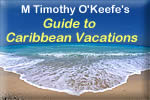Guadeloupe Exploring Pointe-A-Pitre Afoot |
This congested city is a big contrast to the open countryside. | ||||
|
The real beauty of Guadeloupe is in the countryside, as the big-city, congested streets of Pointe-a-Pitre quickly demonstrate. Finding a parking place anywhere in Pointe-a-Pitre is a challenge unless you're there early in the morning, and even then you may need to walk a good distance to the center of town. If this seems out of character for the Caribbean , then so is the stifled feeling created by the intense traffic. The city is so crowded compared to the open spaces of Basse-Terre's countryside it feels almost claustrophobic. Nature has been unkind to Pointe-a-Pitre. It was hit hard by hurricanes in 1979, 1980 and 1989. The 1989 winds of hurricane Hugo were so strong they virtually destroyed almost all the coconut palms on the island. So why visit Pointe-a-Pitre? For its historic and shopping qualities, which are considerable. 1) Place de la Victoire: Named in honor of Victor Hugues's victory over the British in 1794, this shady park is where Hugues put the guillotine to work, lopping off the heads of selected landowners at the end of the 18th century. The streets surrounding the park contain the oldest buildings, though few of the truly old colonial structures survived the earthquake of 1845. 2) Marketplace: A daily, not just a once-a-week event, where island women in colorful costumes sell and haggle over the breadfruit, tomatoes, bananas and other assorted items. You can also buy hats and local spices; in fact, some of the sellers can be quite insistent about it. 3) Shopping: The main streets are rues Noizieres, Frebault and Schoelcher. In addition, a brand-new shopping arcade has opened near the waterfront, targeted specifically at cruise ship passengers and other visitors. 4) Musee St -John Perse: Few outsiders know that a Guadeloupan won the 1960 Nobel for Literature. The museum contains the complete poetry collection, personal effects, documents and photographs of St-John, poet and diplomat. Open Monday through Saturday, 9 a.m. to 12:30 p.m. and 2 p.m. to 6 p.m. 5) Musee Schoelcher: This museum illustrates the life of Victor Schoelcher, who helped abolish slavery in the French West Indies . The ornate museum building alone is worth seeing, even if you never go inside. Open weekdays, 9 a.m. to noon and 2:30 p.m. to 5:30 p.m.
|
|||||
